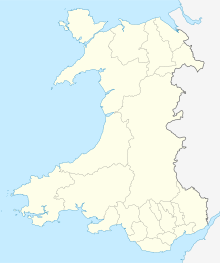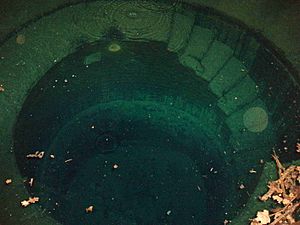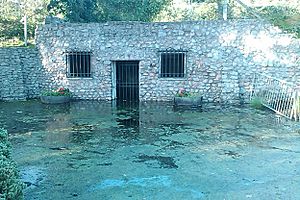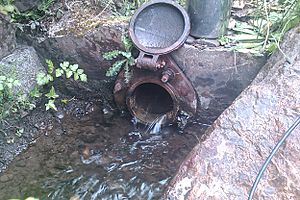Taff's Well Thermal Spring facts for kids
Quick facts for kids Taff's Well Thermal Spring |
|
|---|---|
| Ffynnon Taf (Welsh) | |
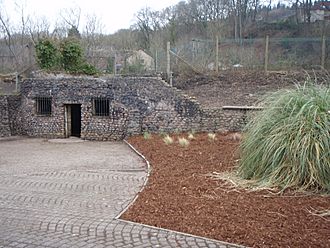
Taff's Well Thermal Spring
|
|
| Location | Wales |
| Coordinates | 51°32′41″N 3°16′17″W / 51.544748°N 3.271488°W |
The Taff's Well thermal spring is a special natural spring found in Taff's Well, a village north of Cardiff in South Wales, UK. It's the only warm spring in all of Wales! The spring water comes out on the east side of the River Taff. A brick building and well were built around it to protect it. You can visit the spring through Taff's Well park, which is a public park.
The spring is inside a stone and brick building that was built in the 1800s. The well itself is about 4 meters deep and made of brick. The building is about 5.3 by 3.9 meters inside, and water fills this space. There's even a spiral staircase made of brick inside the well. An overflow pipe lets extra water flow out into the River Taff.
Scientists believe the water in the spring has traveled a very long way. It comes from limestone rocks far away, and this journey might have taken between 5,000 and 10,000 years!
This special site isn't protected by specific laws, but it is recognized as a "Regionally Important Geological Site" (RIGS). This means it's a very important place for studying rocks and the Earth's history. The building itself is also a Grade II listed building, which means it's historically important.
Contents
History of Taff's Well Spring
The very early history of the Taff's Well spring isn't well known. The first time someone officially wrote about visiting the spring was in 1760. This was done by a chemist named D. W. Linden. Even though Roman settlements were found nearby, there's no proof they knew about or used the spring.
Some old writings say the spring was sometimes called 'Ffynnon Dwym', which means 'tepid well' in Welsh. In 1799, floods were reported to have washed away some old Roman stone structures near the well.
Healing Powers and Popularity
In the 1800s, many books and dictionaries talked about the water's healing powers. People believed it could help cure illnesses, especially rheumatism, which causes joint pain. The spring became very popular in the mid to late 1800s. Many visitors came to the village, hoping the water would make them feel better.
A writer named Hall described the scene in 1861. He wrote about sick and elderly people waiting to bathe in the spring. Only a few people could fit in the bath at a time, so visitors often had to wait for hours. He noted that most of these bathers were poor. Hall believed the waters did help people with long-term illnesses. He even wrote about a young man who arrived on crutches but could run around after two weeks of bathing!
There was also a story about an Irishman who couldn't move without crutches. When asked why he came all the way from Ireland to this well, he said he got his illness in Wales, so it was "St. Taff's" duty to cure him!
In 1877, another chemist, J. W. Thomas, also mentioned the well's fame for curing rheumatism. However, he was a bit more cautious about whether the stories were true.
Changes to the Well
During the 1800s, a weir (a small dam) was built across the River Taff. This made the river wider and caused it to move closer to the spring. Because of this, floods often covered the spring area.
The well building started to fall apart around the time of World War I. But in 1929, the people of Taffs Well decided to fix it up. It reopened in 1930 and even had a small swimming pool! A famous travel writer, H. V. Morton, visited the well in 1932 and wrote about it in his book.
However, a big flood in the 1950s caused the pool and well to stop being used again. In 1978, the well's water was used to save the village's bowling greens during a dry spell. It wasn't until the 1990s that the local council started to redevelop the area.
Today, the Taff's Well spring is not used for drinking water or for swimming. The local council had plans to make it a tourist attraction again, but these plans haven't fully happened yet.
The Grey Lady of Taff's Well
The Taff's Well spring is not thought of as a "Holy Well", even though there are many of those in Wales. But it does have a famous myth or legend connected to it, besides its healing powers. This is the story of the "Grey Lady":
A lady dressed in grey was often seen visiting this well. Many people said they saw her at dusk, walking along the river banks near the spring. She was also seen going towards the ferry near the Garth Mountain. Stories about this mysterious lady were passed down through generations.
The last story says that about 70 or 80 years ago, the woman in grey waved to a man who was getting water. He put his pitcher down and asked how he could help her. She asked him to hold her hands very tightly until she told him to let go. The man did as she asked. He thought it was a very long time before she told him to release her. Then, a sharp pain hit him in his side, and he cried out, letting go. The Grey Lady said, "Oh no! I will stay trapped for another hundred years! Then I must find a woman with steady hands, better than yours, to hold me." After that, she disappeared and was never seen again.
Geology of the Spring
The Taff's Well spring comes out of an area where different types of rocks meet. The rocks around the spring are called "Millstone Grit." Just south of Taff's Well, you can see older rocks called Carboniferous Limestone. Even older rocks, called Old Red Sandstone, are found further southeast.
The ground right around the spring is made up of river deposits like sand and gravel.
There's a large crack in the Earth's crust nearby called the Tongwynlais or Taff's Well Fault. This fault runs very close to the spring. It's a "normal fault," meaning one side of the rock has dropped down compared to the other.
Scientists believe the water flows mostly through the Carboniferous Limestone rocks. As the water goes deep underground, it gets heated by the Earth's natural warmth. Then, it rises back up to the surface at the spring.
Spring Temperature
The Environment Agency Wales has been checking the temperature of the well since 2008.
The warmest temperature recorded was 22.12 °C (about 71.8 °F). The average temperature is around 21.6 °C (about 70.9 °F). The temperature usually stays very steady, only changing by about half a degree Celsius. Sometimes, after heavy rain, the temperature might drop a little. This happens if the spring water mixes with colder river water or groundwater.
The average temperature of 21.6 °C at Taff's Well spring is more than 10 °C warmer than the average groundwater temperature in Wales, which is about 11.3 °C. This shows how special this thermal spring is!
| Temperature °C | Date | Reference |
|---|---|---|
| 18.61 | 1877 | |
| 13 | 1969 | |
| 22 | 1969 | |
| 18.5 | 1969 | |
| 19.6 | 1980 | |
| 20.6 | 1988 | |
| 22.12 | 2008 |
Water Flow
It's rare to measure how much water flows out of the spring's overflow pipe. Old records mention that the well is very close to the river, and its waters are always flowing into it. In 1877, it was described as "very powerful." A rough guess at the time said it produced about 800 gallons of water every hour. That's about 0.001 cubic meters per second.
Ecology: Life in and Around the Spring
There isn't much information about the plants and animals that live in warm waters in the UK. However, a study in Ireland looked at the living things found in thermal and warm waters there.
In the still water inside the Taff's Well spring, scientists found a lot of a type of bacteria called Phormidium ambiguum. These bacteria formed tall, cone-shaped structures up to 40 cm high!
When the well floods, water spreads out into the park, creating a shallow pond next to the building. Algae grows very well in this overflow water because it's still and gets lots of light and oxygen. Inside the well, there's not much oxygen. Two types of stringy algae, Melosira and Spirogyra, have been found and are very common in the flooded area outside the well building.


